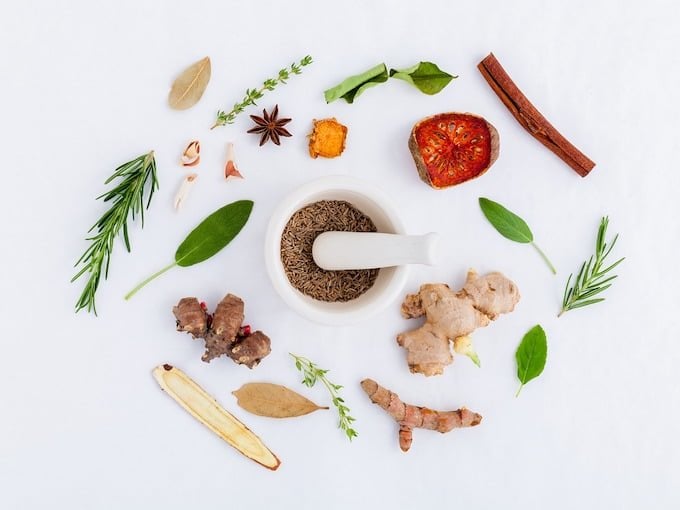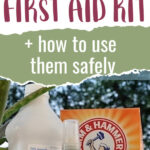How to Make a First Aid Kit With Only All-Natural Ingredients
For almost every common ailment or minor injury, there’s a natural treatment that works and will give you peace of mind about treating them without scary ingredients and unnecessary preservatives. Here’s how to make a first aid kit with only all-natural ingredients for your family.

While you may not put these natural treatments into a little canvas bag or plastic box with a big red cross on it, keep them on hand for fast access when you need to treat someone in your family.
What You Need to Make a First Aid Kit
Here’s what you should keep on hand:
Aloe Vera – Helpful for burns and cuts. It’s easy to have a small aloe plant right outside your back door or in your kitchen window. Break off a piece and put the gel on the wound. If you don’t have the plant, you can buy pure aloe vera gel.
Coconut Oil – Use as the base for salves or making tinctures. Coconut oil is antifungal and beneficial for chapped lips and dry skin. It can also be taken internally and can replace several items in your beauty routine, so choose a good quality coconut oil.
Epsom salts – Dissolve in the bath for sore muscles or to detox. For splinters, soak skin in epsom salts for 15 minutes to help remove the splinter or make it easier to remove with tweezers. We recommend buying epsom salts in bulk to save packaging waste.
Baking soda – A great bee sting remedy and everyday bug bites, plus see the DIY section below for other uses for baking soda. Opt for aluminum free baking soda.
Witch Hazel – Keep Witch Hazel on hand for cleaning cuts and scrapes. Plus it’s the most cost-effective skin toner around, and it’s super useful for postpartum recovery.
Vinegar – Apple Cider Vinegar with “the mother” can be applied topically to rashes or taken internally for a variety of digestive issues.
Hydrogen Peroxide – Use for the initial cleaning of wounds, then switch to water so you don’t repeatedly kill off good bacteria. Peroxide can also help with ear infections. Place a dropper full of Hydrogen Peroxide in the ear and let rest for 15 minutes or until it stops bubbling.
Garlic oil – Garlic oil is a solid go-to for ear infections, parasites that cause diarrhea, and colds. Mullein can be added as well.
Essential oils – Every natural first aid kit should include lavender, eucalyptus, peppermint, and tea tree essential oils. These essential oils may help with most childhood ailments from headaches, minor burns and insect bites, congestion, toothaches, cold sores and digestive issues.
How to Use Your Natural First Aid Supplies
Sunburn
Bathe in cool water with Epsom salts to ease the pain. After bath, towel off and apply pure aloe vera gel to the sunburn. Few things will soothe sunburn like aloe vera gel. Keep an aloe vera plant handy in your yard and break off a leaf to rub the juice on sunburns (works great on cuts and scrapes, too).
Cuts & Scrapes
You can use Witch Hazel, vinegar or peroxide to clean the wound and aloe vera gel to help soothe the irritated skin.
Bruises
There are a few really effective herbal remedies for bruising you can keep in your first aid kit. The most useful one is Arnica gel.
Mosquito Bites
Few things are more irritating in the summer heat than mosquito bites. To help stop the itch, make a paste using baking soda and water and apply it to the bite.
An alternative treatment is to crush 3 plain adult aspirin tablets and mix them with water (just a few drops) to make a paste and apply to the bite twice a day.
And to prevent mosquito bites in the first place, see below for a simple recipe for DIY natural insect repellent.
Bee Sting Remedy
First, make sure the person isn’t allergic to bee stings. If they are, forget any home remedy and get medical attention immediately.
If there are no allergy considerations, remove the stinger by running the edge of a credit card along the welt on the skin (works better than tweezers and you’re more likely to have a credit card handy than a pair of tweezers anyway). Now what to put on a bee sting? Mix 2 teaspoons of baking soda with about a quarter teaspoon of water to make a thick paste and apply it to the sting. Leave it on there until the pain stops.
An alternative treatment is to mix baking soda, vinegar, and meat tenderizer to make a paste and apply it to the sting. Again, leave the paste on until the pain stops.
Regardless of which paste you use, apply ice to the sting after you remove the paste to reduce swelling. You can try 10 other bee sting remedies here.
Poison Ivy
Pour rubbing alcohol on the affected area and then wash it immediately with cool water and soap to remove as much of the plant sap as possible. Dry the skin and apply the meat side of a banana peel on the skin to help dry out the rash.
Swimmer’s Ear Home Remedy
Who doesn’t like spending time in the pool or at the beach during the summer? The downside, other than sunburn, can be swimmer’s ear. First clean the ear by mixing equal parts of water, apple cider vinegar and rubbing alcohol and put one drop into each ear and let it dry. Do this twice a day.
An alternative treatment is to mix equal parts of water, white vinegar, and peroxide. Put one drop into the ear and allow it to dry. This can also be done twice a day.
DIY Essential Oil Mosquito Repellent
Why go to the trouble of putting together a natural first aid kit if you’re going to keep spraying your family down with DEET every day before they go outside to keep mosquitoes at bay? Commercial insect repellents are toxic, smell awful and can cause skin rashes and breathing problems in people sensitive to the chemicals they contain. Here’s an effective essential oil mosquito repellent you can feel good about using (and it smells great, too!)
In a 4-ounce glass spray bottle with a fine mist setting, combine:
- 3 ounces of distilled water
- 15 drops of Citronella essential oil
- 10 drops of Lavender essential oil
- 10 drops of Eucalyptus Globulus essential oil
- 5 drops of Lemongrass essential oil
Shake the bottle each time before you use it. Essential oils don’t dissolve in water. If you don’t shake the bottle before each use you run the risk of getting the concentrated oils on your skin instead of the diluted version, and you could have some skin irritation as a result.
Mist your skin and clothing with the mixture and reapply it as needed.
The great thing about natural first aid treatments is that you will have most of these items in your kitchen pantry or bathroom medicine cabinet. The key is knowing how to use them to treat common illnesses and injuries and having them in a place where you can get to them quickly when you need them.
Natural First Aid from the Kitchen Pantry & Spice Rack
Many people are surprised to find those little tins and bottles of spices in your kitchen cabinet can also be used in a pinch for natural first aid. It’s simple to take down a tin of a spice, put some in your hand, add a little carrier oil or purified water and make a quick poultice. You can also use them to make a quick medicinal tea. As always, make sure they are organically grown and pure.
Here are a few herbs and spices you can use for natural first aid:
Basil – good for relieving headaches because it has antispasmodic properties. It will also help with nervous indigestion and stress induced insomnia.
Cardamom – good for clearing the lungs. You can use it in a tea.
Chives – works in a way very similar to garlic but it’s not as strong. Very good for indigestion and to boost the respiratory system. If you find you have a problem with garlic, try chives instead.
Cinnamon – clears congestion, stimulates circulation and has strong antiseptic qualities.
Cloves – a great pain killing herb used extensively for toothaches but it can also be used to relieve nausea.
Dill – excellent for colic and indigestion. You can give it in a tea or a tincture.
Ginger – excellent for nausea, congestion, sore throats, colds and flu.
Rosemary – great for congestion and for digestive problems.
Sage – a great liver tonic and helps with digestion after a meal of fatty or greasy food. It also has antiseptic properties so use it for colds, flu and sore throats.
Thyme – excellent for coughs, colds, sore throats and giving the immune system a boost.
Turmeric – one of the absolute best spices for the immune system and has strong anti-tumor and antibiotic properties. You can also apply it topically in a paste or poultice for burns, cuts, scrapes and bruises.
Honorable Mention OTC Natural First Aid Supplies
If the idea of making your own salves is overwhelming, there are some ready made options available with safe ingredients. Here are a few we trust and use with our own families:
Boiron Arnica Gel – For the past 14 years, Boiron has gotten us through pregnancy and child birth pains, bike wrecks, and dozens of scrapes.
First Honey Sterile Honey Ointment – Made from New Zealand Manuka honey, this ointment protects against infection and helps speed healing time. Honey is also amazing for natural scar prevention.
Waxelene Soothing Botanical Jelly – A much healthier substitute for petroleum jelly, this is the base for many herbal remedies and salves we make at home. It’s organic, hypoallergenic, and great for soothing dry skin.
NoseFrida Baby Nasal Aspirator – The safest and most hygienic way to relieve baby’s stuffy nose. If you don’t believe it, look for images of a cross-sectioned bulb syringe.

